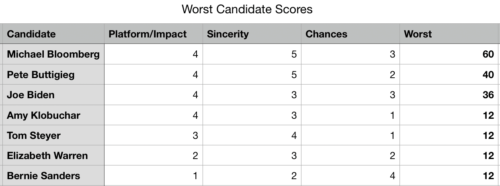
Back in the summer, I came up with a scale and rating system to evaluate each of the Democratic candidates and figure out which one is the worst. You can find that here. I think it’s time to revisit the question of the worst Democratic candidate. Joe Biden ‘won’ the previous results. Pete Buttigieg followed him somewhat distantly as the second worst.
Why was Biden the worst candidate? Some of it’s his platform, though several other candidates – notably Buttigieg and Amy Klobuchar – are just as bad on platform. The biggest difference was that Biden had a great chance of winning, and so it was the combination of bad platform and strong chance of winning that made him the worst.
After Biden’s faceplant in Iowa and New Hampshire, his chances have gone down. And so, I thought running this idea again might change things. Biden might no longer be the worst candidate. Maybe now it’s…Buttigieg? Someone else?
Let’s find out.
I’ll start by reviewing the scale I used last time, since I’m using it again.
The Scale
I’m rating each candidate from 1 to 5 on the three factors above. ‘1’ is the best score, and ‘5’ is the worst score. Furthermore, I’m not going to just add the numbers up. Instead, I’ll multiply them. These three factors function more as intensifiers than as merely cumulative. They feed off each other, and I want scores that reflect this fact.
On to the interpretations…
Platform and Impact
1 = Positive. Candidates who would leave the world a better place than they found it.
2 = Neutral. Candidates who may work hard and have good intentions, but have enough negatives that they’d probably leave the world about as they found it.
3 = Mildly Negative. Candidates who would continue some Trump/W. Bush style policies and oppose others. Most generic liberal Democrats land here.
4 = Negative. Candidates who would actively leave the world worse off. Most generic moderate Democrats land here.
5 = Ruinous. Candidates who would cause harm on the scale of a George W. Bush or Donald Trump.
Sincerity
1 = Totally Committed. Candidates who hold to their principles more or less no matter what. No one is going to score here.
2 = Committed. Candidates who have a consistent platform across time and hold to their principles in the vast majority of cases.
3 = Generic Politician. Candidates who sometimes grandstand for the crowd or issue disingenuous statements, but are usually straightforward about where they stand.
4 = Frequently Disingenuous. Candidates who very significantly and/or frequently change their views to match those of interest groups, donors, and/or changing constituencies.
5 = Pants on Fire. Candidates who engage in Donald Trump-esque levels of dishonesty, flip-flopping, and/or bullshitting. No one is going to score here.
Chance of Winning the Nomination
0 = Effectively Zero. There’s no remotely plausible scenario where this person wins the nomination. Since zero multiplied by anything is zero, I drop these candidates from the results. If you look at the results below and your candidate is missing, that’s why.
1 = Very Low. Candidates who aren’t competitive, but who could become competitive in a not totally implausible future.
2 = Low. Candidates who could make a strong run, but probably won’t.
3 = Competitive. Candidates who are seriously competitive for the nomination, but still have some work to do.
4 = Very Competitive. Candidates who could win the nomination and no one should be at all surprised.
5 = Strong Frontrunner. Candidates who are the strong favorite to win the nomination.
Worst Democratic Candidate: February 2020 Edition
And now, here are the results from February 2020.

The first notable thing? The worst candidate isn’t Pete Buttigieg, though he’s pretty close. It’s…Michael Bloomberg! Why Bloomberg rather than Buttigieg?
For one, even though Buttigieg did well in Iowa, he’s not a frontrunner in the race. He could win, but it’s still rather unlikely. But two, and more importantly, Michael Bloomberg did the unthinkable: he scored as badly as Donald Trump on ‘sincerity’ (in fact, so does Buttigieg these days…). In effect, Bloomberg is an American Oligarch trying to buy the presidency. His platform is about as bad as Biden’s and Buttigieg’s, but his overall approach to politics lands him a spot as one of the worst Democratic candidates in decades.
“Wait, are Amy Klobuchar, Bernie Sanders, and Elizabeth Warren really the same?”
Of course not. Sanders has a much better platform than Warren, and Warren has a much better platform than Klobuchar. But their chances of winning the nomination are very different. Klobuchar is a big long shot. Warren is unlikely to win, but would be less of a shocker than Klobuchar. And Sanders is arguably the frontrunner at this point, albeit a weak one. Those differences are why they score the same.
The Return of Tom Steyer
In the earlier version of this ranking – the one from Summer 2019 – I didn’t even include Steyer in the evaluation. Why’s he in this time?
Here’s why. His chances of winning the nomination are now high enough that it makes sense to at least consider the possibility. He blanketed Nevada and South Carolina in advertising. As a result, he polled fourth or fifth in Nevada and polls third in South Carolina. He polls ahead of Klobuchar in both states and ahead of Buttigieg and Warren in South Carolina.
Will Steyer win the nomination? It’s very unlikely. But it’s probably more likely than Klobuchar winning and almost as likely as Warren winning. For those reasons, he’s in.